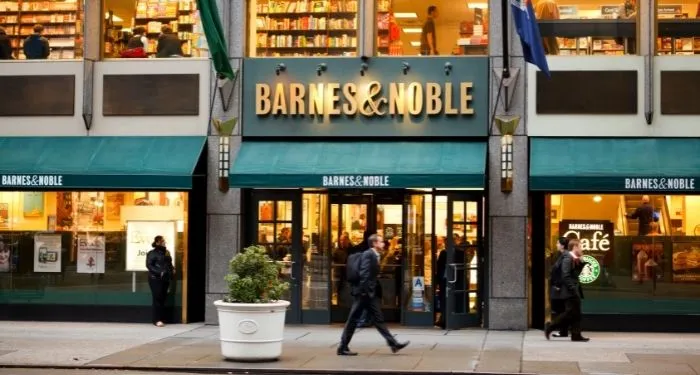
What Is Going On With Barnes & Noble?
If you’ve been seeing the chatter on Twitter about Barnes & Noble not stocking debut hardcovers, you’re not alone. Writers recently sounded the alarm after hearing from various sources (other writers, B&N reps, former B&N employees, other industry professionals, etc.) that the chain’s stores would only be stocking hardcovers that had proven sales records. When I saw this conversation take off, it pinged the former-bookseller part of my brain that has been tracking bricks-and-mortar news, because B&N has made quite a few changes to their stores in the past two years, and they’re worth looking at.
Before we dive in, let me give you my credentials. I’m by no means an expert, nor do I (or have I ever) work for a publisher or for Barnes & Noble. I got my start in bookselling; I was hired by Borders in 2004 (RIP, Borders!), worked for independent bookstores from 2005 to 2015, and have been working for Book Riot since then. I’m also the co-editor of two anthologies, Sword Stone Table with Swapna Krishna and (coming in 2023!) Fit for the Gods with S. Zainab Williams, neither of which will ever be published in hardcover (because anthologies). So while this conversation doesn’t affect me directly, as a publishing auntie and citizen reader it’s something I take seriously.
Let’s take the newest news first: While much of this is anecdotal, it’s not likely that Barnes & Noble would go on the record about this kind of policy and there are enough supporting responses on Bethany Baptiste’s tweet on August 17th to make it clear that many authors with hardcover releases, particularly in Kids and Middle-Grade, are not being stocked even in their local B&N stores. This isn’t limited to debut authors, either; Kelly Yang, the award-winning author of the Front Desk series, posted a video in which she announced she had been specifically told that B&N would not be stocking the newest book in the series. Scroll through the responses to Baptiste’s tweet, and you’ll see many others with the same story. Independent publisher Disruption Books weighed in to note that this holds true with their own experience.
B&N is a key piece of the in-person bookselling world. Despite Amazon controlling the lion’s share of book sales in the US, everyone in publishing (including indie bookstores) seems united in agreeing that without B&N as even a small counterweight to the e-commerce behemoth, bookselling as we know it would be doomed. As Ellen Adler, publisher of New Press, told the New York Times, “It’s funny how the industry has evolved so that they are now a good guy… I would say their rehabilitation has been total.” And while highly selective buying practices are par for the course – it’s impossible for any store to carry every book published, and any store has to be able to select for what they believe they can sell – with stores across the country, B&N fills an important role in the ability of readers to discover new authors. This, above all other things, is one of the reasons that buyers bringing in fewer hardcovers is such a scary thought for so many authors.
We’ll get into discovery and the potential impact of this later, but first I want to talk about some pieces of “what’s actually happening” and “why now.” There are a few factors to consider here, and we’ll start with B&N’s recent sale and leadership revamp. In 2018, the board fired its chief executive; a summer later, hedge fund Elliott Advisors purchased the chain and put James Daunt in charge. Daunt was responsible for taking the UK chain Waterstones from bankruptcy to profitability, and he has gained some ground for B&N since 2019. Despite the pandemic decimating foot traffic to many branches, sales were up 3% in 2021 over pre-pandemic numbers in 2019. Daunt’s strategy includes:
- Down-sizing the central office formerly responsible for ordering for all stores, limiting them to a minimal order, and allowing store managers greater discretion in what to bring in based on local sales
- Eliminating co-op displays (or “pay to display”, to put it in more practical language), in which publishers could purchase premium placement for specific titles
“Other priorities include further narrowing the mix to books, educational games, puzzles and workbooks; store refurbishments that include an emphasis on smaller tables and wider aisles; expanding online (only 10 percent of sales); and reducing out-of-stocks,” notes RetailWire.
Smaller tables, you say? That means less room for those stacks of new hardcovers. Stores also have more discretion over what they promote, and if you don’t already know that retailers are dedicating those spaces to sell titles that are, say, hot on BookTok, you do now. It’s smart business, there’s no doubt! Customers, especially teenagers whose dollars retailers are hungry to acquire, are now just as likely (if not more) to come in looking for a book they saw blowing up on social media as an older customer might be to look for a book that they saw reviewed in the New York Times or heard about on NPR. And those books that are blowing up on BookTok? Not necessarily debuts, or hardcovers for that matter! Many of them are books that have been out for years, that new readers are only just discovering thanks to the magic of algorithms.
Again, not a bad thing for books in general, or authors lucky enough to get a BookTok bump! But let’s add another piece to this puzzle. While the pandemic has been overall good for reading, with specific types of books getting huge sales increases (educational books for young readers, for example), it hasn’t necessarily been great for debuts or for hardcovers. Book sales are currently down across formats in Q1 2022 vs. Q1 2021, and while many expected it (nothing gold can stay), a 12.4% drop in hardcover sales is not something that bookstores, publishers, or authors are going to feel blasé about. It’s also not likely to get any better, considering that the US is staring down the barrel of a recession and continuing to deal with rising prices.
So let’s add that together for B&N: Central ordering has been down-sized, publishers can no longer pay for placement, stores have less display room, and hardcover sales are down. Add to that the anecdata about B&N buyers being even warier of bringing in newer authors, and you’ve got a recipe for panic.
Which brings us to impact. Discovery is the perennial Holy Grail of publishing: how do you get someone to see or hear about (and then hopefully buy) your new book? There’s no one right answer (and anyone who tells you otherwise is selling something) but physical discovery, i.e. walking into a bookstore and seeing that book on a display table, has long been one of the key elements – which is why publishers have historically been willing to pay for those display spots. (Shout-out to indie bookstores, who do the hard work of supporting authors and discovery every damn day.) It’s what everyone who loves to go to any bookstore loves about being in a brick-and-mortar store: you can pick up a book, read a page or two, look at the synopsis, maybe see a shelf-talker by a staff member, maybe take it home, despite never having heard of it before. Online retailers have been trying to duplicate that experience with varying (mostly crappy) success for decades. So currently, the only places to get that experience are in physical bookstores. And while superstores like Costco, Target, and Wal-Mart do carry books as well, paperbacks are their bread and butter.
All of which adds up to, any shift by B&N to carry fewer hardcovers is a blow to discovery, and therefore to authors. If the only hardcovers you can find at your local branch are also the ones that are on the bestseller list, which are also the ones getting marketing dollars, which are also the ones that the algorithms are suggesting to you online, then the chances of, say, a debut author from a marginalized community getting their book in front of your face long enough for you to see it and consider buying it are lower than ever. And let’s be real here: decreases in discovery disproportionately affect authors from marginalized communities. As #PublishingPaidMe showed, Black authors (as well as other authors of color) are paid less for their work, even when they win awards and/or make the bestseller lists. (And while there are many initiatives, organizations, and individuals working towards greater diversity in publishing, we’ve got a long way to go in terms of publishing diversely.) Marketing budgets are often tied directly to advances – so the less a publisher pays for a book, the less money they are likely to spend promoting it. Sales of your first book often determine whether or not you get another book contract, and how much you’re paid for it.
There are no good answers here, and it’s true that none of this is necessarily new – it’s the next step in a continuing reduction of literal shelf space. The more people buy online, the harder it is for bricks-and-mortar stores to stay afloat (unless you are actually ordering from those stores, and most people are not). The fewer hardcovers people buy, the fewer hardcovers those stores will order. I have sympathy for buyers who, in efforts to keep their stores profitable, have to make hard choices about what they can successfully stock. But I have just as much sympathy (maybe even more) for the authors who see yet another door closed to them, who are told by fans or friends that their books aren’t in stock at the B&N around the corner, who just want readers to be able to find their book. How do you develop a proven sales record when your book isn’t in stock? Spoiler: you can’t.
While there are no good answers, there are good actions we all can take. Visit your local bookstores if you’ve got ’em. You can support a debut author by looking for their book in your store, and asking the store to stock it if they don’t already. You can and should also ask for it in your library! Libraries make up a chunk of the hardcover market, and it costs you, personally, zero dollars. Help spread the word about books however you like – tell a friend in person, talk about it on-line, write a review, put a copy in a Little Free Library. Seek out authors new to you, and give them a chance. The book eco-system can survive, and our choices can make a difference.
Editor’s note: A previous version of this article referred to Bethany Baptiste by her joke Twitter name.












